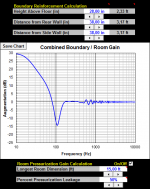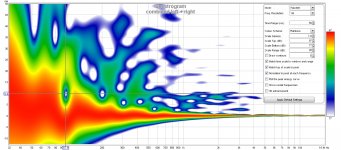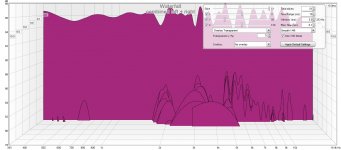You have cozy room to play music and guitar in.
Null moves little higher in frq with new values for speaker distances, first is with longest room dimension as 15' and the other with 20' but this parameter don't change position of null just room gain below a knee at around 60Hz.
Null moves little higher in frq with new values for speaker distances, first is with longest room dimension as 15' and the other with 20' but this parameter don't change position of null just room gain below a knee at around 60Hz.
Attachments
BYRTT,
Thanks, I definitely enjoy spending time in the "man loft".
I think your calculated result is definitely close enough to reality to consider the mystery solved. So, the width of the room does not matter here?
wesayso,
I was thinking the same thing about combined response when I was last posting. I've attached a couple of new graphs (based on the same corrected IR).
Thanks, I definitely enjoy spending time in the "man loft".
I think your calculated result is definitely close enough to reality to consider the mystery solved. So, the width of the room does not matter here?
wesayso,
I was thinking the same thing about combined response when I was last posting. I've attached a couple of new graphs (based on the same corrected IR).
Attachments
Thanks. I really am pleased.
On another note, I haven't yet calibrated my crappy interface; I guess I should look into that?
On another note, I haven't yet calibrated my crappy interface; I guess I should look into that?
Couldn't hurt. Being pleased is good! I love it that you could do it with such simple means. Glad to see REW keeps evolving which also made this possible.
Spreadsheet hasn't a room width setting and the length setting only interfere with null if room is extremely small such as a toilet room size. When playing around in the spreadsheet looks like to get rid of nasty nulls in lows trick is to get the three speaker position boundary distances as different as possible but then speaker position end up a position that is not practical or nice looking.
Think you have very nice data thinking over its listening position measurement, and the tracks you shared the other thread with room mixed into track sound nice, although i know you now have changed the correction since.
Myself will have to look into measurements at listening position this year.
Think you have very nice data thinking over its listening position measurement, and the tracks you shared the other thread with room mixed into track sound nice, although i know you now have changed the correction since.
Myself will have to look into measurements at listening position this year.
Thanks to the Gang of Three (Greg, Ron, Rahul) for all the good info and batch files for DRC. I've jumped in and given it a try. 
I do my measurements in HOLM, not REW, because I don't want Java on my main laptop. I export the impulse as 32 bit float normalized, then convert to RAW with Audacity or Goldwave. I've run the Normal, 7-cycle, ERB and Soft scripts provided in the first post. I combine to stereo and normalize the resulting files to -27dBFS RMS. That leaves a dB or so headroom, depending on the correction. The level adjusted files are saved as stereo 32 bit float for use in JRiver.
All sound different, all sound good in some ways. All seem better behaved than the system with no EQ. Normal sounds closest, tonally to no EQ, but better of course. I like the ERB best, I think. 7-cycle is sorta of weird and distant. Probably a glitch. Anyway it's a good start and I look forward to learning more about how to tweak it.

I do my measurements in HOLM, not REW, because I don't want Java on my main laptop. I export the impulse as 32 bit float normalized, then convert to RAW with Audacity or Goldwave. I've run the Normal, 7-cycle, ERB and Soft scripts provided in the first post. I combine to stereo and normalize the resulting files to -27dBFS RMS. That leaves a dB or so headroom, depending on the correction. The level adjusted files are saved as stereo 32 bit float for use in JRiver.
All sound different, all sound good in some ways. All seem better behaved than the system with no EQ. Normal sounds closest, tonally to no EQ, but better of course. I like the ERB best, I think. 7-cycle is sorta of weird and distant. Probably a glitch. Anyway it's a good start and I look forward to learning more about how to tweak it.
Pano,
Thanks so much for reporting back; I'm hopeful that this will be a worthwhile endeavour for you.
Please know that the 3-8 cycle config files are slightly tweaked versions of the standard config files (minimum, soft, normal, erb, etc...). They can be slightly more "touchy" since they are not using the additional (freq dependent) ringing truncation stage as well as employing a little bit more linear phase behavior, and therefore I would recommend starting with 4-5 cycles to get a feel for them.
I've gotten nice results with the erb curve myself, though I've always gravitated back towards a simpler and more conservative windowing. Recently, while playing around a bit after making a system change (something I rarely do), I made a minimum phase erb filter (ringing truncation engaged) and was very impressed. The step response was a shockingly neat right triangle and the focus and stability of the center phantom image with mono recordings was incredible. Since I prefer the sound of spaced-mic recordings anyway (as well as good off-axis
sound), I'm happiest with a weaker filter.
I'm looking forward to hearing more from you. Good luck and happy listening.
Thanks so much for reporting back; I'm hopeful that this will be a worthwhile endeavour for you.
Please know that the 3-8 cycle config files are slightly tweaked versions of the standard config files (minimum, soft, normal, erb, etc...). They can be slightly more "touchy" since they are not using the additional (freq dependent) ringing truncation stage as well as employing a little bit more linear phase behavior, and therefore I would recommend starting with 4-5 cycles to get a feel for them.
I've gotten nice results with the erb curve myself, though I've always gravitated back towards a simpler and more conservative windowing. Recently, while playing around a bit after making a system change (something I rarely do), I made a minimum phase erb filter (ringing truncation engaged) and was very impressed. The step response was a shockingly neat right triangle and the focus and stability of the center phantom image with mono recordings was incredible. Since I prefer the sound of spaced-mic recordings anyway (as well as good off-axis
sound), I'm happiest with a weaker filter.
I'm looking forward to hearing more from you. Good luck and happy listening.
 Thanks to you and your guide, it was easy to get started.
Thanks to you and your guide, it was easy to get started.Listening tonight I found male voices slightly heavy and hollow, so need to work on that. I do agree that DRC does very good things for the center image. That was the first thing I noticed . I'll try some 4 cycle correction to hear what it does.
My listening room is probably unique, it's a lava cave under my house. 70' long by ~22' wide, various hight. Hypo-echoic, rather dry acoustics. There are reflections, but they are so chaotic as to be unnoticeable.
Good to see you in here Pano...
Lot's of things to try. I agree with Greg to keep the window relatively short. My reason for that is similar as well. When you move from the sweet spot to off axis positions it feels more natural. It also gives me the most natural sound way off axis. It could be that your "room" behaves quite different though. One touch makes my processing different from Greg, that is the longer window at higher frequencies that I use. I found it brings me more focus in the phantom centre without the drawbacks in the off axis positions.
I wrote that off as unique for the type of speaker I use, but it may be fun to try anyway.
I have experimented with exaggerated window lengths just to learn what to listen for. That made me aware I could more easily tolerate long window settings for the higher frequencies. It wasn't until I made my correction in the low end shorter (6 cycles) that things snapped into place way off axis. With that I mean it sounded natural there. Even way off axis trough the kitchen door.
Lot's of things to try. I agree with Greg to keep the window relatively short. My reason for that is similar as well. When you move from the sweet spot to off axis positions it feels more natural. It also gives me the most natural sound way off axis. It could be that your "room" behaves quite different though. One touch makes my processing different from Greg, that is the longer window at higher frequencies that I use. I found it brings me more focus in the phantom centre without the drawbacks in the off axis positions.
I wrote that off as unique for the type of speaker I use, but it may be fun to try anyway.
I have experimented with exaggerated window lengths just to learn what to listen for. That made me aware I could more easily tolerate long window settings for the higher frequencies. It wasn't until I made my correction in the low end shorter (6 cycles) that things snapped into place way off axis. With that I mean it sounded natural there. Even way off axis trough the kitchen door.
This is amazing. A few posts ago I joked about having a "man loft" instead of a "man cave", and now we're joined by someone who actually has a cave. Too cool. I can't imagine having too many resonance issues with open baffle speakers in a lava cave.
Starting with the 3-5 cycle filters is probably a good idea so as to make sure no artifacts are appearing* (I lived happily for a while with the 4 cycles filter) since the custom config files that generate these filters don't have the built in over-correction "protection" that the standard ones have. For the sake of reference to the custom config files, the "minimum" config file specifies a 5 cycle window and the" normal" is using a 10 cycle window.
*Although discovering artifacts in a cave sounds like fun (sorry I couldn't help it).
Starting with the 3-5 cycle filters is probably a good idea so as to make sure no artifacts are appearing* (I lived happily for a while with the 4 cycles filter) since the custom config files that generate these filters don't have the built in over-correction "protection" that the standard ones have. For the sake of reference to the custom config files, the "minimum" config file specifies a 5 cycle window and the" normal" is using a 10 cycle window.
*Although discovering artifacts in a cave sounds like fun (sorry I couldn't help it).
Yeah, what is it with stray cats and the big island? They seem to be everywhere.
Sharing a link to Pano's Troglodytes. They're really awesome!
http://www.diyaudio.com/forums/multi-way/269864-caveman-speakers-troglodytes.html
Sharing a link to Pano's Troglodytes. They're really awesome!
http://www.diyaudio.com/forums/multi-way/269864-caveman-speakers-troglodytes.html
BYRTT,
Thanks again. I once tried the Cardas speaker placement method but I didn't get as far as actually listening because I couldn't live with the speaker location. Interestingly enough, the side/far wall ratio I have now is pretty close to what that method specifies (I have about 3:3:8 rather than 3:5:8). It's interesting that most methods consider distance from 3 walls but not the floor like your calculator. Anyway, I probably won't be playing around too much with new placement in the near future because I think what I have now is a pretty good compromise.
ra7,
Thanks for the link; I caught up a little on Pano's cave. Amazing and awesome. Looking forward to more feedback about correction efforts (not like it seems to need much help).
Thanks again. I once tried the Cardas speaker placement method but I didn't get as far as actually listening because I couldn't live with the speaker location. Interestingly enough, the side/far wall ratio I have now is pretty close to what that method specifies (I have about 3:3:8 rather than 3:5:8). It's interesting that most methods consider distance from 3 walls but not the floor like your calculator. Anyway, I probably won't be playing around too much with new placement in the near future because I think what I have now is a pretty good compromise.
ra7,
Thanks for the link; I caught up a little on Pano's cave. Amazing and awesome. Looking forward to more feedback about correction efforts (not like it seems to need much help).
If you were a stray cat, where would you want to live? 😀Yeah, what is it with stray cats and the big island? They seem to be everywhere.
I'm also looking forward to hearing what DRC can do for me. The cave is probably the only room I've been in that does not get in the way of the recordings. It's an unusual experience. So mostly I'll be fixing the speakers, not the room. I'll be busy most of this month and not able to play much. Hope to catch a little time in a couple of weeks to do further DRC tweaking. Will certainly post results as soon as I have them.
Mr. Raimonds Skulurls started a new thread on Room Correction or Speaker Correction
As I suspect that thread to be moved to another part of the forum I wanted to link it here and quote his first post:
As I suspect that thread to be moved to another part of the forum I wanted to link it here and quote his first post:
Hello,
I see high interest about the subject here. I would like to offer my expertise collected in 14 years of serving professionals.
Let’s start with discussion with Dr. Floyd Toole about his paper "The Measurement and Calibration of Sound Reproducing Systems":
https://secure.aes.org/forum/pubs/journal/?ID=524
The full version of discussion is available here:
http://aplaudio.com/downloads/Reading_Dr_Toole.pdf
And what can be corrected – loudspeakers or room:
http://aplaudio.com/downloads/Equalizing_loudspeakers.pdf
BR,
Raimonds
Mr. Raimonds Skulurs
Hasty post obviously, it should say: Mr. Raimonds Skuruls. My excuses.
wesayso thanks links to interesting reading, will maybe try the trial version for TDA measurement software in it looks very interesting but price tag not very diy.
Thanks BYRTT,wesayso thanks links to interesting reading, will maybe try the trial version for TDA measurement software in it looks very interesting but price tag not very diy.
It is for professionals.
Please make your offer : )
Thanks BYRTT,
It is for professionals.
Please make your offer : )
Your TDA software does look very interesting and useful. Please describe advantages over using open source software like that used by Gmad or Wesayso to achieve the same goal. I think many of the graphical tools appear to be similar to what we can see in a package like REW.
- Home
- Loudspeakers
- Full Range
- A convolution based alternative to electrical loudspeaker correction networks



